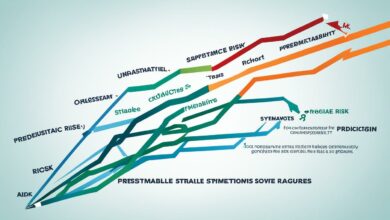The Role of Implied Correlation in Options Trading: Strategies and Applications

Understanding Implied Correlation
Implied correlation in options trading is a crucial concept that provides valuable insights into market expectations. It essentially measures how closely the prices of different assets, typically within an index, move in relation to each other. This metric helps traders understand the relationship between individual stock movements and the overall index.
Definition and Significance
Implied correlation is defined as the market’s expectation of the average correlation between the returns of individual stocks and the return of an index. A higher implied correlation indicates that stock prices are expected to move more synchronously, while a lower implied correlation suggests more independent movements among stocks.
Significance:
- Risk Management: Helps in assessing portfolio diversification benefits.
- Market Sentiment: Indicates systematic risk and expected market volatility.
- Trading Strategies: Guides strategies like dispersion trading and sector rotation.
Calculation Methods
The Chicago Board Options Exchange (Cboe) offers a widely recognized method for calculating implied correlation through its Implied Correlation Index. The index is derived from the following components:
- Implied Volatility of Index Options: Reflects the market’s expectation of future volatility for the entire index.
- Implied Volatility of Individual Stock Options: Reflects expected volatility for each stock within the index.
The Cboe Implied Correlation Index uses these volatilities to compute an average implied correlation, providing a single indicator that represents market-wide expectations.
Market Expectations and Influence on Index Components
Implied correlation significantly reflects market expectations by indicating how investors believe individual stocks will behave relative to one another. For example:
- During periods of economic stability, implied correlations tend to be lower as stock movements are more influenced by company-specific factors.
- In contrast, during market turmoil or economic crises, implied correlations spike as broader market factors dominate individual stock performances.
Influence on Index Components:
- High Implied Correlation: Suggests limited benefits from diversification as most stocks move together.
- Low Implied Correlation: Indicates better diversification opportunities since individual stock movements are less synchronized.
Understanding these dynamics enables traders to make informed decisions about risk allocation and strategy selection, enhancing their potential for profitability in various market conditions.
Additional Resources for Traders
For those interested in expanding their knowledge about options trading, including understanding different types and styles of options, exploring the intrinsic value of options, or learning about the limitations of popular indicators like MACD, there are numerous resources available online. These can provide deeper insights into various aspects of trading and help refine strategies for better outcomes.
The Impact of Implied Correlation on Options Pricing Dynamics
 Implied correlation plays a crucial role in determining the pricing dynamics of various options, such as index options and single-stock options. Understanding this relationship can help you make informed trading decisions.
Implied correlation plays a crucial role in determining the pricing dynamics of various options, such as index options and single-stock options. Understanding this relationship can help you make informed trading decisions.
Index Options Pricing
For index options, implied correlation is a significant factor influencing their pricing. When implied correlation is high, it suggests that the individual stocks within an index are expected to move more uniformly. As a result, the overall volatility of the index tends to be lower than the sum of volatilities of the component stocks. This uniform movement can lead to tighter spreads and lower premiums for index options.
Conversely, when implied correlation is low, it indicates that stocks are likely to move more independently. The divergence in stock movements increases the overall volatility of the index, resulting in wider spreads and higher premiums for index options. Traders often use this information to gauge whether an index option is overpriced or underpriced based on current market expectations.
Single-Stock Options Pricing
In contrast, for single-stock options, implied correlation affects their pricing through its impact on individual stock volatility. High implied correlation typically signifies that external market factors are driving stock prices uniformly. This scenario can reduce the individual stock’s idiosyncratic risk and thus lower its implied volatility.
On the other hand, low implied correlation allows for more significant differences in individual stock movements. This increases each stock’s unique risk component, leading to higher implied volatilities for single-stock options. Understanding these dynamics helps traders assess whether single-stock options are priced appropriately relative to their expected movements.
Role of Volatility
Volatility assessments are essential in shaping traders’ perspectives on pricing dynamics influenced by changes in implied correlation:
- High Volatility: When market conditions exhibit high volatility, changes in implied correlation can significantly impact option pricing due to increased uncertainty.
- Low Volatility: During periods of low volatility, shifts in implied correlation might have a more nuanced effect but still provide crucial insights for strategic adjustments.
By closely monitoring implied correlation and associated volatility levels, traders can better navigate the complexities of option pricing and optimize their strategies accordingly.
Exploring Advanced Options Strategies
To further enhance your trading strategy beyond understanding implied correlations and volatility assessments, it’s worth exploring advanced options strategies such as the Synthetic Long Options Strategy. This strategy can be particularly useful when you want to leverage your position without having to buy the underlying asset outright.
Additionally, understanding different types of options like Call Options can provide you with more tools in your trading arsenal. Each type of option has its own set of rules and benefits that can be strategically used depending on market conditions.
Moreover, choosing the right broker is crucial for successful options trading. You might want to explore the various types of options brokers available to find one that aligns with your trading goals.
Finally, familiarizing yourself with models such as the Black Scholes Model can further deepen your understanding of modern options pricing and help you make more informed trading decisions.
For a deeper
Advanced Strategies for Trading Based on Implied Correlation
1. Dispersion Trading
Definition and Mechanics
Dispersion trading is a sophisticated strategy leveraging the differences between the implied volatilities of index options and individual stock options. By analyzing implied correlation, you can predict how closely related the price movements of stocks within an index will be. Lower implied correlations suggest that individual stock movements are less synchronized with the index, providing opportunities for dispersion trades.
Execution Tactics
To execute a dispersion trade:
- Sell Index Options: When you expect low correlation among index components, selling index options can be profitable since the overall index volatility may be lower than the combined volatilities of individual stocks.
- Buy Individual Stock Options: Simultaneously, purchasing options on individual stocks within the index capitalizes on their higher volatility compared to the index.
Case Study Example Using S&P 500
Consider a scenario with the S&P 500:
- Suppose the implied correlation is relatively low.
- You sell at-the-money S&P 500 index calls.
- At the same time, you buy at-the-money calls on a selection of high-volatility stocks within the S&P 500.
If these stocks experience significant price movements while the index remains stable due to diversified performance among its constituents, this strategy can yield substantial returns.
2. Correlation Swaps
Overview and Structure
Correlation swaps are derivatives that allow traders to speculate on or hedge against changes in correlation between asset returns. The payout depends on the difference between realized correlation over a period and a predetermined strike level.
Implementation Strategy
In trading correlation swaps:
- Fixed vs. Realized Correlations: Enter into swaps where you pay a fixed rate and receive a payoff based on realized correlations, or vice versa.
- Profit Scenarios: Profit occurs if realized correlations deviate significantly from expected levels set at contract initiation.
Practical Examples
A successful trade might involve anticipating increased market turbulence leading to higher correlations during an economic downturn. Entering into a swap with this expectation can result in substantial gains if your prediction holds true.
3. Volatility Arbitrage
Conceptual Framework
Volatility arbitrage involves exploiting discrepancies in implied volatility across different financial instruments. Variations in implied correlation often lead to mispriced volatilities among options.
Identifying Mispriced Volatilities
Monitor shifts in implied correlation to spot undervalued or overvalued options:
- Low implied correlations can indicate undervalued individual stock options relative to index options.
- High implied correlations might signal overvalued stock options.
Example Scenarios
Implementing delta-neutral strategies by combining long and short positions in mispriced options allows you to profit from volatility differences without exposure to market direction.
4. Sector Rotation Using Implied Correlation
Enhancing Sector Rotation Strategies
Sector rotation involves shifting investments among different sectors based on expected performance trends. Insights from implied correlation trends enhance this strategy by identifying periods of varying sector correlations with broader markets.
Analysis of Varying Sector Correlations
Different market conditions impact sector correlations:
- During economic expansions, sectors like technology may show lower correlations with defensive sectors such as utilities.
- In recessions, sector correlations typically increase as systemic risk rises.
Understanding these dynamics aids in making informed rotation decisions, optimizing portfolio performance through strategic allocation adjustments based on predicted correlation shifts.
2. Correlation Swaps
Correlation swaps are complex financial instruments that allow traders to bet on how closely a group of assets will move in relation to each other in the future. Unlike dispersion trading, which involves directly buying and selling options, correlation swaps offer a simpler way to profit from changes in correlation.
Overview and Structure
Correlation swaps work by exchanging fixed correlation rates for actual correlations over a specific period. The fixed rate is agreed upon at the beginning of the swap, while the realized correlation is calculated based on the actual performance of the underlying assets during the contract term. The payout of a correlation swap depends on the difference between these two rates.
Implementation Strategy
To implement a correlation swap strategy, you focus on:
- Fixed vs. Realized Correlations: If you anticipate that realized correlations will be higher than the fixed rate, you would enter into a long position in a correlation swap. Conversely, if you expect lower realized correlations, a short position would be more appropriate.
- Profit Scenarios: Profits arise when your prediction about future correlations turns out to be accurate. For instance, if you have a fixed rate of 0.3 and the realized correlation comes in at 0.5, your long position would generate profit based on this differential.
Practical Examples
Consider an example where you’re analyzing sector rotations using implied correlation trends. Suppose that during a period of market uncertainty, you notice that different sectors exhibit varying degrees of correlation with the broader market:
- You enter into a long position in a correlation swap with a fixed rate of 0.4.
- Over time, as volatility increases due to economic events or earnings reports, realized correlations rise to 0.6.
In this scenario, your long position would benefit from the increased realized correlations compared to the fixed rate.
Another practical application involves volatility arbitrage, where shifts in implied correlations create mispricing opportunities:
- Suppose tech stocks are expected to have low correlations with each other compared to their historical averages.
- By entering into an appropriate correlation swap, you could capitalize on these anticipated changes in correlations.
Moreover, understanding how options work can significantly enhance your trading strategies. For instance, one might wonder “can you sell a call option before the expiry date?” This aspect of options trading could intersect with your use of correlation swaps in various ways.
By understanding and leveraging correlation swaps, you can enhance your trading strategies and gain exposure to unique profit opportunities driven by changes in asset relationships.
3. Volatility Arbitrage
Volatility arbitrage in options trading leverages insights from implied correlation to identify and exploit mispriced volatilities. This strategy involves buying and selling options to capitalize on volatility differences between various assets, typically maintaining a delta-neutral position to hedge against directional market moves.
Identifying Mispriced Volatilities
Shifts in implied correlation can lead to discrepancies in the pricing of options. Traders seek these mispriced opportunities by:
- Analyzing historical vs. implied volatilities.
- Monitoring changes in the Cboe Implied Correlation Index.
- Utilizing statistical models to forecast volatility patterns.
For instance, if implied volatility for an index is significantly higher than the aggregate implied volatilities of individual components, it may indicate an opportunity for volatility arbitrage. Conversely, decreasing implied volatility can have significant consequences on your investment portfolio, necessitating strategies to manage risks and maximize returns.
Example Scenarios
- Scenario 1: Divergent Implied Volatilities Suppose the S&P 500 index options show an implied volatility of 20%, while the average implied volatility of its components is only 15%.
- You could sell index options (high volatility) and buy individual stock options (low volatility), aiming to profit as these volatilities converge.
- Scenario 2: Earnings Announcements Prior to earnings season, individual stocks often exhibit higher implied volatilities due to expected announcements.
- If the overall market sentiment remains stable, you might find mispriced volatilities between index and stock options, presenting an arbitrage opportunity.
Volatility arbitrage requires meticulous analysis and precise execution but offers potential rewards by exploiting inefficiencies derived from implied correlation shifts.
4. Sector Rotation Using Implied Correlation
Sector rotation strategies can be significantly enhanced by leveraging insights from implied correlation trends. By understanding how different sectors correlate with the broader market, you can optimize your trading decisions based on changing market conditions.
Key Points:
- Implied Correlation Trends: Monitoring implied correlation trends helps identify periods where specific sectors are more or less correlated with the overall market. When implied correlation is low, it suggests that individual sector performance may diverge from the broader index, presenting opportunities for sector-specific trades.
- Sector Analysis: During different market conditions, sector correlations can vary widely. For instance, during economic downturns, defensive sectors like healthcare and utilities often exhibit lower correlations with the market compared to cyclical sectors such as technology and consumer discretionary.
Practical Applications:
- Identifying Opportunities: Use implied correlation data to spot sectors that are likely to outperform or underperform relative to the market. A drop in implied correlation might indicate a good time to rotate into less correlated sectors.
- Risk Management: Adjust your portfolio’s risk profile by rotating into sectors with lower correlations during periods of high market volatility. This strategy mitigates systematic risk and capitalizes on sector-specific strengths.
- Combining Strategies: Integrate this approach with other advanced trading strategies like dispersion trading or volatility arbitrage. For example, combine sector rotation insights with delta-neutral strategies to hedge against market movements while targeting specific sector gains.
Using implied correlation for sector rotation provides a nuanced view of market dynamics, allowing you to make informed decisions that align with prevailing trends and volatility differences across sectors. Additionally, understanding holiday trading schedules such as whether the stock market operates on Christmas Eve, can further refine your investment strategy during those periods.
Furthermore, exploring different investment strategies such as trend-following can also provide additional avenues for maximizing returns in conjunction with sector rotation and implied correlation analysis.
Case Studies: Implied Correlation in Action
Analyzing historical events provides valuable insights into the behavior of implied correlation during times of market stress. The financial crisis of 2008 and the COVID-19 pandemic are two prime examples.
Financial Crisis of 2008
During the financial crisis of 2008, implied correlation surged dramatically. Market participants expected a high degree of co-movement among various assets due to systemic risk and widespread uncertainty.
Key Factors During the Financial Crisis:
- Increased Systemic Risk: The collapse of major financial institutions led to panic, causing investors to sell off assets across the board.
- Implied Correlation Spike: The Cboe Implied Correlation Index reflected this by showing heightened correlation among S&P 500 components.
- Trading Implications: High implied correlation suggested limited benefits from diversification. Traders focused on macro-level strategies rather than individual stock picking.
For instance, selling index options while hedging with single-stock options became less attractive due to the uniform movement of stocks. This is where understanding financial derivatives becomes crucial, as these instruments often play a key role in such trading strategies.
COVID-19 Pandemic
The COVID-19 pandemic presented a different scenario, yet also resulted in significant changes in implied correlation levels.
 Key Developments During the COVID-19 Pandemic:
Key Developments During the COVID-19 Pandemic:
- Initial Shock: At the onset, implied correlations spiked as markets reacted to global lockdowns and economic shutdowns.
- Sector Divergence: Over time, certain sectors like technology and healthcare outperformed, leading to reduced correlations within indexes.
- Trading Opportunities: This divergence created opportunities for dispersion trading. For example, traders could sell options on broad market indices while buying options on outperforming sectors or stocks.
The implications were clear:
- Early Stage (High Correlation):
- Strategies focused on macro trends with high volatility expectations.
- Later Stage (Sector Divergence):
- Dispersion trading gained prominence as sector-specific performance varied significantly.
These case studies underline how understanding shifts in implied correlation can help traders navigate periods of market turmoil effectively.
Both events illustrate the dual nature of challenges and opportunities that arise from changing implied correlations, providing a roadmap for developing resilient trading strategies during volatile times.
Challenges and Considerations in Trading Based on Implied Correlation
Implementing strategies based on implied correlation involves various challenges that traders need to navigate. One of the primary concerns is data quality issues. Accurate and timely data is crucial for calculating implied correlations and making informed trading decisions. Inconsistent or outdated data can lead to incorrect assumptions about market conditions, causing potential losses.
Data Quality Issues:
- Accuracy: Ensuring that the data used for implied correlation calculations is accurate is vital. Incorrect data can distort correlation metrics, leading traders to make poor decisions.
- Timeliness: Market conditions can change rapidly. Delayed data might not reflect current market dynamics, making it less useful for real-time trading strategies.
- Source Reliability: Different data providers may have varying methodologies for calculating implied correlations. Traders must rely on reputable sources to minimize discrepancies.
Another significant challenge is the transaction costs associated with multi-contract trading impacts. Strategies like dispersion trading often require multiple contracts, which can accumulate substantial costs.
Transaction Costs Consideration:
- Commissions: Each trade in a multi-contract strategy incurs a commission fee. These fees can add up quickly, eating into potential profits.
- Slippage: The difference between the expected price of a trade and the actual price can vary significantly in fast-moving markets, impacting overall returns.
- Bid-Ask Spread: Wider spreads can lead to higher costs when entering and exiting trades, particularly in less liquid markets.
Combining these elements, traders must consider the overall cost of executing a strategy before committing capital. High transaction costs can erode the profitability of even well-planned trades based on implied correlation insights.
Navigating these challenges requires a disciplined approach and continuous evaluation of both data quality and transaction costs. Using advanced tools and maintaining rigorous standards for data reliability helps mitigate some risks. Additionally, optimizing execution tactics to minimize transaction costs ensures that strategies remain viable and profitable over time.
For those looking to further refine their trading strategies, especially in the context of intraday options trading, understanding these challenges and considerations becomes even more crucial.
Moreover, it’s essential to consider the broader implications of these challenges on market efficiency and liquidity. Understanding these factors not only aids in better decision-making but also helps in developing strategies that are resilient to such challenges. Furthermore, delving into the intricacies of financial market transactions could provide valuable insights that enhance trading performance in the long run.
Conclusion
Understanding and effectively utilizing implied correlation offers advanced traders strategic advantages through informed decision-making. By grasping the nuances of how implied correlation shapes market expectations and influences option pricing dynamics, you can tailor your trading strategies to capitalize on these insights.
Key takeaways include:
- Accurate Pricing: Leveraging implied correlation helps in more accurate pricing of index and single-stock options.
- Risk Management: Improved risk allocation by understanding the relationships between individual stock movements within an index.
- Profit Opportunities: Identifying dispersion trading, correlation swaps, and volatility arbitrage as profitable avenues based on shifts in implied correlation.
Your ability to interpret and act on changes in implied correlation can be a game-changer in achieving a competitive edge in the options market.







